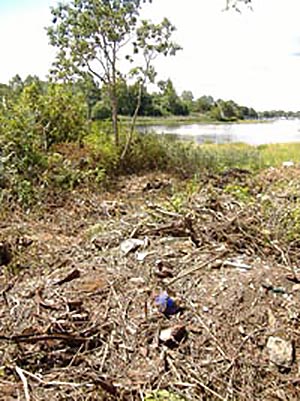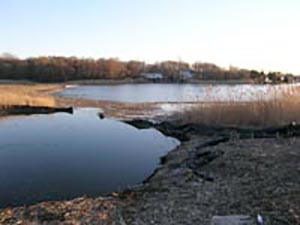
RI Coastal Resources Management Council
...to preserve, protect, develop, and restore coastal resources for all Rhode Islanders

...to preserve, protect, develop, and restore coastal resources for all Rhode Islanders
Warwick Neck Overlook Project will improve wildlife habitat, water quality
May 11, 2006, WARWICK—A restoration project is currently underway at the top of Warwick Cove off of Warwick Neck Avenue, at an area known to local residents as “The Overlook.” The project began last fall, and is a collaborative effort among the RI Coastal Resources Management Council (CRMC), the City of Warwick, the Natural Resources Conservation Service (NRCS) and the University of Rhode Island’s Cooperative Extension Education Center (CEEC).
The collaboration is part of a larger partnership between CRMC and the URI CEEC, and was prompted by the Warwick Neck Improvement Association’s efforts to beautify the site for Warwick Neck residents. In October 2005, the Improvement Association sponsored the removal of overgrown and invasive trees and shrubs from the southern end of the site, which improved views as well as sight lines for traffic on Warwick Neck Avenue. At that time, CRMC and the URI CEEC determined that the area would be a suitable site for habitat restoration, as well as a place to demonstrate sustainable landscaping practices, which are techniques that seek to improve ecosystem health and water quality by reducing inputs of fertilizers and pesticides, and preventing runoff of pollutants into surface water bodies such as Warwick Cove.
“The Warwick Neck Overlook Project will benefit the entire community, and the CRMC is eager to begin planting at the site, along with University of Rhode Island’s Cooperative Extension Education Center,” said CRMC Executive Director Grover J. Fugate. “The CRMC is pleased at how responsive all the partners have been on this project and how quickly this has come together through this spirit of cooperation. Similar restoration projects in the past have taken more than a decade.
“By removing invasive plants and restoring the salt marsh, we will improve the view, enhance coastal wildlife habitat and protect water quality. Although small in size, Warwick Neck Overlook is an important part of the coastal environment, and the CRMC is pleased that we can restore this vista to its natural state.”
The next phase of the project will involve restoration of the salt marsh habitat. When URI surveyed the site last fall, they discovered that a large area of salt marsh had been filled in and used as a residential dump, probably in the early part of the 20th century. Trash, glass bottles, tractor parts and what appeared to be hurricane debris were revealed when the site was excavated by City of Warwick DPW crews in March of this year. A large portion of the old dump has since been removed and the area filled in with a sand medium that will be suitable for salt marsh plants. The area has been re-graded in order to allow tidal water to flow into the marsh restoration area. This influx of saltwater will help to prevent the growth of Phragmites australis, an invasive plant species that has little wildlife habitat value. Once the composition of vegetation is changed, the site will be able to support a more diverse community of fish and wildlife.
In addition to salt marsh species, various native shrubs and groundcovers will be planted this fall between the road and the marsh to create a buffer zone of vegetation that will replace other invasive species such as Asiatic bittersweet and Japanese knotweed. The restoration planting is being coordinated by the URI CEEC with guidance and funding for plant materials provided by NRCS through the Wildlife Habitat Incentives Program, and assistance from the Warwick Neck Improvement Association and the Warwick Neck Garden Club. The CEEC will also be collaborating with the Improvement Association and Garden Club to develop a maintenance plan for the site once the new vegetation is established.
CRMC and URI’s overall goals for the project are to educate the public about the value of salt marsh habitats and coastal buffer zones in the hopes of fostering stewardship of Rhode Island coastal waters. Though the restoration area itself is relatively small (about half an acre), it is surrounded by existing salt marsh. By restoring the area that has been degraded, and reconnecting the areas that already have habitat value, the benefits of the project will extend well beyond its geographical boundaries.
The URI Cooperative Extension Education Center is part of URI’s College of the Environment and Life Sciences. The Center is a one-stop educational facility offering programs and resources on environmentally-sound home and garden practices based on University research.

BEFORE

AFTER